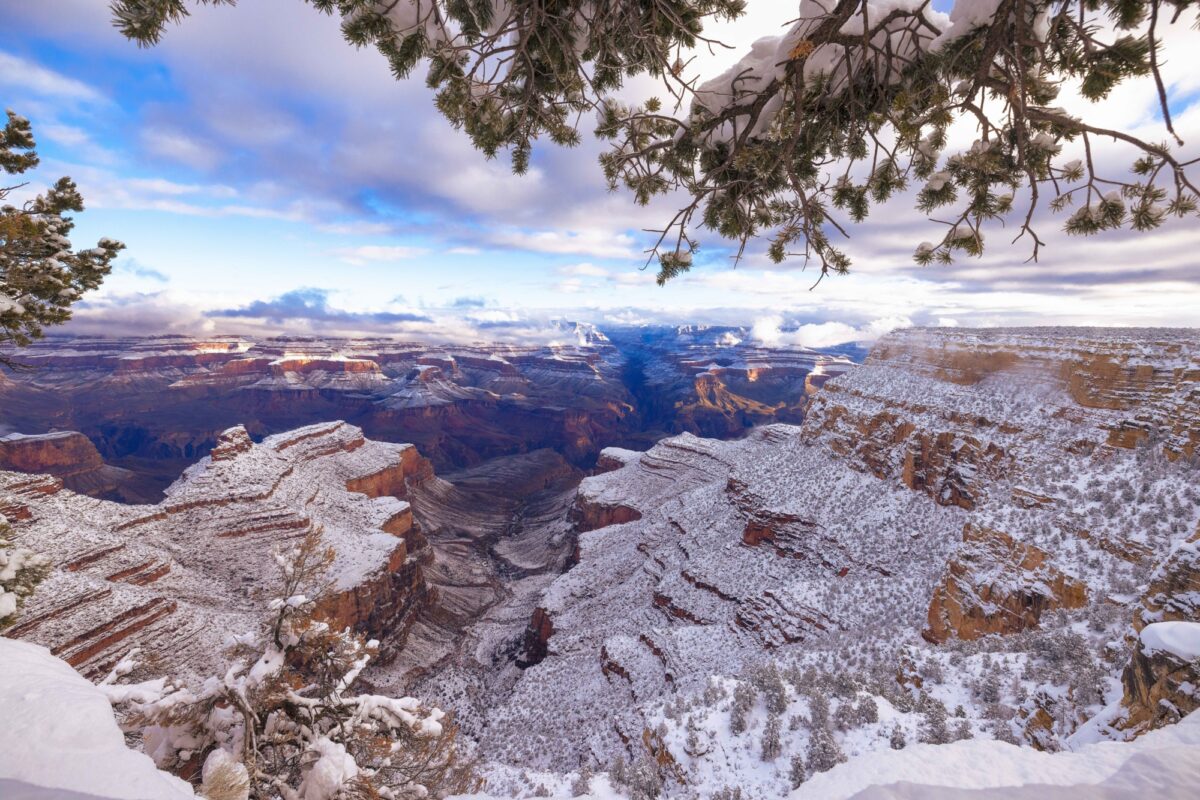Preparedness is Key: Living at the North Rim During the Winter
The North Rim provides a place of peace and solitude. A place to slow down and appreciate what is in front of you—but what happens in the winter months when the gates close?

The North Rim is visited by only 10 percent of Grand Canyon visitors yearly and is more remote than people think. The nearest grocery store is in Kanab, Utah, one and a half hours away, and the closest Costco is three hours away in St. George, Utah. There is one lodge and one campground, all over 8,000 feet above sea level. The North Rim provides a place of peace and solitude. A place to slow down and appreciate what is in front of you—but what happens in the winter months when the gates close?
The North Rim is typically open with services available from May 15 to October 15 each year. Highway 67 closes to vehicle traffic for the winter. If you wanted to get to the North Rim developed area, you would have to ski, hike, or snowshoe 45 miles from Jacob Lake (one way). If you did make the journey, you would need all the winter camping gear and supplies required to spend a night or more outside in extremely cold temperatures. Twenty-two employees, concession staff, and family members stayed on the North Rim through the 2023 winter season, and this number varies from winter to winter.
These employees and partners are Law Enforcement Rangers, Interpretation Rangers, Maintenance Rangers, Emergency Medical Services providers, Firefighters, Search and Rescue Rangers, and volunteers in various departments. They are responsible for keeping the roads clear, moving any hazards, working on projects for the upcoming summer season, building maintenance, and making sure that whoever decides to make the long journey either across the canyon or up from Jacob Lake is prepared for the harsh environment, and more.
The North Rim is closed in the winter months not just because of the amount of snowfall but because of the brutal cold weather patterns. Its infrastructure was also not built to maintain a year-round operation. DeMotte Meadow, just outside of the park boundary, can sometimes reach 30 degrees below zero (Fahrenheit) or more. To add insult to injury, the average winter snow depth for the North Rim is 40.8”. During the winter of 2022-23 (October 2022 to March 2023), the North Rim received an amazing 246.7”! In fact, the 194.2” received between January and March 2023 made 2023 the second snowiest on record (between 1925-2023). The current infrastructure makes it difficult to accommodate any more employees or visitors during the winter months with these cold temperatures. More times than not, the power will go out, and the North Rim will have to rely on diesel-powered generators to be able to use electricity. Preparedness is critical for living on the North Rim in the winter.
Elyssa Shalla, North Rim District Interpreter, talked about how preparedness is key on the North Rim.
“We need to ensure we have all our self-rescue and personal protective equipment ready for winter. We never go out without a full search and rescue pack, and our packs in the winter are different than in the summer. Every time we leave the rim, we bring our gear so we can be prepared to spend the night out in winter conditions if something happens. Forty-five miles of driving seems short in the summer, but it’s a long way away in the winter. My winter coat is rated to 40 or 60 degrees below zero, as with my boots and gloves. I know I can take care of myself and have done the work to prepare for the conditions.”
Some winters can be mild, while others, like this past winter, pose difficult conditions and challenges. With the road completely covered in snow, the only way to get to Jacob Lake is via snowcat, which can be an uncomfortable ride. It can hold a maximum of five individuals with limited gear and go about 13 miles per hour on groomed terrain. On drifty snow it can go four miles per hour with snow up to the windshield. It takes three and a half hours by snowcat on a good day to get to Jacob Lake but with snow on the ground it can take up to six and a half hours. Most people take this machine out for a grocery run, as many of their vehicles are parked at Jacob Lake. However, employees must plan in advance, as they need to be prepared with emergency supplies and an inReach satellite communications device, and must communicate with dispatch before leaving the developed area. Grocery shopping tends to be a challenge when the ride back is via snowcat!
Jeff Caton, a park ranger working in Facilities Management, said that this year some of the snow drifts on the side of Highway 67 were over ten feet high, making it difficult to move snow around. They tried to keep the highway from the North Rim developed area to Jacob Lake plowed during this year’s record snowfall, but it was a big challenge with equipment failures and no breaks between storms.
“The snow was five feet deep and was compact and dense in spots out there,” he said. “A lot of people think we can just push the snow out of the way, but we need to scoop it, lift it, and dump it. In my average nine-hour workday I can plow about a mile of the 45-mile stretch. I take my jet boil, soup, coffee, snacks, and water with me for the day. If I need to go to the bathroom, I will be standing in at least waist-deep snow.”
The North Rim has employees during the winter months to maintain the facilities, protect the resource, and offer emergency services to those needing it. There are visitors that make the grueling trek up the North Kaibab Trailhead from the canyon floor and those that make the adventurous 45-mile trek from Jacob Lake.
Shalla remembered meeting unprepared hikers at her doorstep one evening. “I remember hearing someone knocking on my door. To my surprise, there were four young guys wearing running shorts and tee shirts, and it was the middle of winter. They asked if they could stay overnight as they were not prepared. They thought they could do a rim-to-rim-to-rim during winter but did not expect the conditions up here. We helped them devise a plan to get back in the canyon to head back to the South Rim safely the next day.”
The North Rim can feel isolating and remote but the benefits of living in a place of solitude can outweigh the conveniences of city life.
Jesse Barden, a park ranger with Interpretation and Resource Education, enjoys trail running both in the winter and summer. He reflected on a special moment he had with the canyon this past winter. “The snow had been falling gently all day. A few powdery inches had accumulated on the road, enough to dampen the sound of footsteps but not enough to make walking a chore. It was around 20 degrees outside, so I put on my warm running clothes and headed out the door. I ran slowly (the only speed I have at 8,000 feet) toward the lodge, enjoying the soft snow and dimming light. At the lodge, I post-holed around to the veranda to get a view of the canyon. Clouds were shrouding the buttes and swirling in the side canyons. Snow below the rim emphasized the canyon’s colorful layers. It was so quiet that I could hear the rushing of Transept Creek 6,000 feet below. Then, I heard a faint rumbling far in the distance. As it grew louder, I recognized it as rocks tumbling from somewhere deep in a side canyon. The rumbling subsided, but not for long. Moments later the sound of more rocks falling split the air. This pattern continued while I stood, enthralled by the sights and sounds of the Grand Canyon becoming grander.”
Many people think that the housing arrangements are also harsh because of the isolated North Rim environment. Caton mentioned that living conditions are better than one might think. “We have apartments, and I just got Starlink internet to stay connected. We enjoy watching shows and reading books on our days off like any other person. I think that sometimes people think we huddle around a fire like barbarians, but that just is not true at all. However, you do need the mindset and mentality to live up here. This winter is frustrating but rewarding. I’ve never lived where you can hear snowfall, but on the North Rim in the winter, you can.”
With only 22 people living on the North Rim in the winter, the sense of community is small but mighty. “Sometimes we probe down the North Kaibab Trail in our snowshoes as a group, we ski, we hike, we run, sometimes we do community potlucks, and the general vibe is to get out there for mental health,” said Shalla. “Many people do take winter leave.”
The North Rim of Grand Canyon is a unique environment in both the winter and summer months. The winters are harsh and frigid, but the employees up there are paid in vivid snowy sunsets and quiet soundscapes. Without those willing to stay over the winter months on the North Rim, facilities could be compromised, search and rescue and emergency services may not be possible, and the summer season could be impacted.
Next time you visit the North Rim, thank a Park Ranger.
Author: Lauren Cisneros



